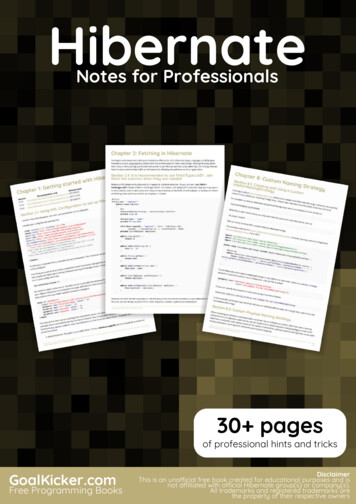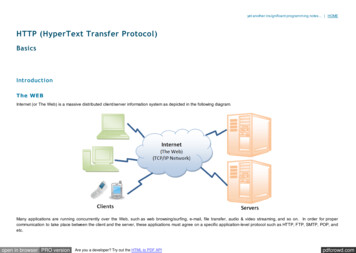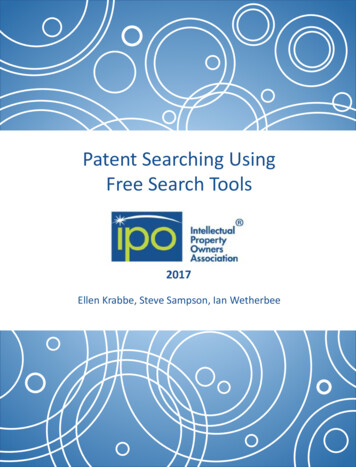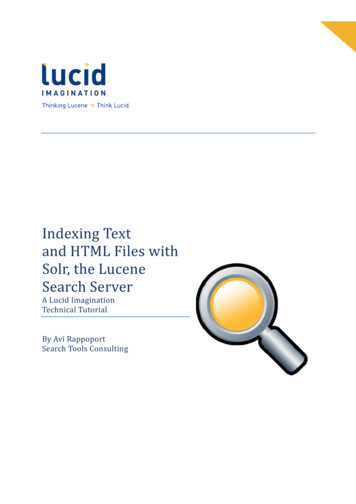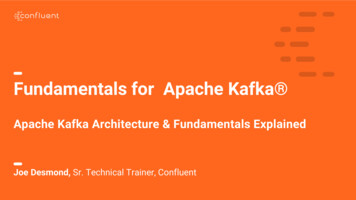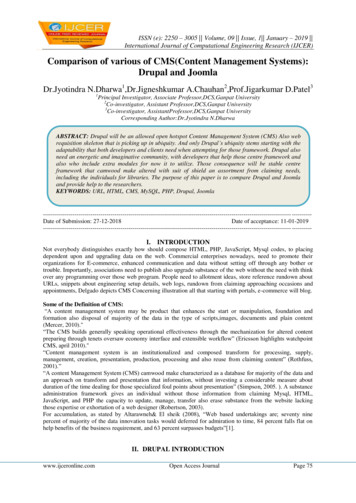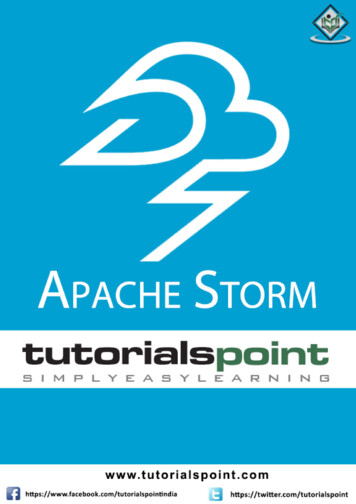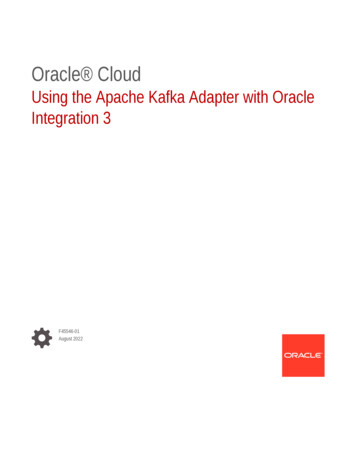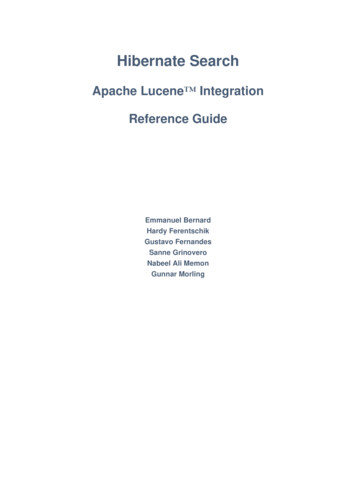
Transcription
Hibernate SearchApache Lucene IntegrationReference GuideEmmanuel BernardHardy FerentschikGustavo FernandesSanne GrinoveroNabeel Ali MemonGunnar Morling
Hibernate Search: Apache Lucene Integration: ReferenceGuideby Emmanuel Bernard, Hardy Ferentschik, Gustavo Fernandes, Sanne Grinovero, Nabeel AliMemon, and Gunnar Morling5.5.8.Final
Preface . vii1. Getting started . 11.1. System Requirements . 11.2. Migration notes . 11.3. Required libraries . 11.3.1. Using Maven . 21.3.2. Manual library management . 21.4. Deploying on WildFly . 31.5. Configuration . 31.6. Indexing . 61.7. Searching . 71.8. Analyzer . 81.9. What’s next . 102. Architecture . 112.1. Overview . 112.2. Back end . 122.2.1. Lucene . 122.2.2. JMS .2.2.3. JGroups .2.3. Reader strategy .2.3.1. shared .2.3.2. not-shared .2.3.3. Custom .3. Configuration .3.1. Enabling Hibernate Search and automatic indexing .3.1.1. Enabling Hibernate Search .3.1.2. Automatic indexing .3.2. Configuring the IndexManager .3.2.1. directory-based .3.2.2. near-real-time .3.2.3. Custom .3.3. Directory configuration .3.3.1. Infinispan Directory configuration .3.4. Worker configuration .3.4.1. JMS Master/Slave back end .3.4.2. JGroups Master/Slave back end .3.5. Reader strategy configuration .3.6. Serialization .3.7. Exception handling .3.8. Lucene configuration .3.8.1. Tuning indexing performance .3.8.2. LockFactory configuration .3.8.3. Index format compatibility .3.9. Metadata API 36424344
Hibernate Search3.10. Hibernate Search as a WildFly module . 443.10.1. Use the Hibernate Search version included in WildFly . 453.10.2. Update and activate latest Hibernate Search version in WildFly .3.10.3. More about modules .3.10.4. Using Infinispan with Hibernate Search on WildFly .4. Mapping entities to the index structure .4.1. Mapping an entity .4.1.1. Basic mapping .4.1.2. Mapping properties multiple times .4.1.3. Embedded and associated objects .4.1.4. Associated objects: building a dependency graph with @ContainedIn .4.2. Boosting .4.2.1. Static index time boosting .4.2.2. Dynamic index time boosting .4.3. Analysis .4.3.1. Default analyzer and analyzer by class .4.3.2. Named analyzers .4546464848485657646464656666674.3.3. Dynamic analyzer selection . 724.3.4. Retrieving an analyzer . 744.4. Bridges . 754.4.1. Built-in bridges . 754.4.2. Tika bridge . 774.4.3. Custom bridges . 784.4.4. BridgeProvider: associate a bridge to a given return type . 834.5. Conditional indexing . 854.6. Providing your own id . 884.6.1. The ProvidedId annotation . 884.7. Programmatic API . 894.7.1. Mapping an entity as indexable . 914.7.2. Adding DocumentId to indexed entity . 914.7.3. Defining analyzers . 924.7.4. Defining full text filter definitions . 934.7.5. Defining fields for indexing . 954.7.6. Programmatically defining embedded entities . 964.7.7. Contained In definition . 974.7.8. Date/Calendar Bridge . 984.7.9. Declaring bridges . 994.7.10. Mapping class bridge . 1004.7.11. Mapping dynamic boost . 1015. Querying . 1035.1. Building queries . 1055.1.1. Building a Lucene query using the Lucene API . 1055.1.2. Building a Lucene query with the Hibernate Search query DSL . 1055.1.3. Building a Hibernate Search query . 115iv
Hibernate Search5.2. Retrieving the results . 1235.2.1. Performance considerations . 1235.2.2. Result size .5.2.3. ResultTransformer .5.2.4. Understanding results .5.3. Filters .5.3.1. Using filters in a sharded environment .5.4. Faceting .5.4.1. Creating a faceting request .5.4.2. Setting the facet sort order .5.4.3. Applying a faceting request .5.4.4. Interpreting a Facet result .5.4.5. Restricting query results .5.5. Optimizing the query process .5.5.1. Logging executed Lucene queries .6. Manual index changes .6.1. Adding instances to the index .1241241251261291311341361361371381381391401406.2. Deleting instances from the index .6.3. Rebuilding the whole index .6.3.1. Using flushToIndexes() .6.3.2. Using a MassIndexer .6.3.3. Useful parameters for batch indexing .7. Index Optimization .7.1. Automatic optimization .7.2. Manual optimization .7.3. Adjusting optimization .8. Monitoring .8.1. JMX .8.1.1. StatisticsInfoMBean .8.1.2. IndexControlMBean .8.1.3. IndexingProgressMonitorMBean .9. Spatial .9.1. Enable indexing of Spatial Coordinates .9.1.1. Indexing coordinates for range queries .9.1.2. Indexing coordinates in a grid with spatial hashes .9.1.3. Implementing the Coordinates interface .9.2. Performing Spatial Queries .9.2.1. Returning distance to query point in the search results .9.3. Multiple Coordinate pairs .9.4. Insight: implementation details of spatial hashes indexing .9.4.1. At indexing level .9.4.2. At search level .10. Advanced features .10.1. Accessing the SearchFactory 51152153155156158159159160163163v
Hibernate Search10.2. Accessing the SearchIntegrator . 16310.3. Using an IndexReader . 16310.4. Accessing a Lucene Directory .10.5. Sharding indexes .10.5.1. Static sharding .10.5.2. Dynamic sharding .10.6. Sharing indexes .10.7. Using external services .10.7.1. Using a Service .10.7.2. Implementing a Service .10.8. Customizing Lucene’s scoring formula .10.9. Multi-tenancy .10.9.1. What is multi-tenancy? .10.9.2. Using a tenant-aware FullTextSession .11. Further reading .vi164164165165167167168168170171171171173
PrefaceFull text search engines like Apache Lucene are very powerful technologies to add efficient freetext search capabilities to applications. However, Lucene suffers several mismatches when dealing with object domain models. Amongst other things indexes have to be kept up to date andmismatches between index structure and domain model as well as query mismatches have tobe avoided.Hibernate Search addresses these shortcomings - it indexes your domain model with the help of afew annotations, takes care of database/index synchronization and brings back regular managedobjects from free text queries. To achieve this Hibernate Search is combining the power of Hibernate [http://www.hibernate.org] and Apache Lucene [http://lucene.apache.org].vii
Chapter 1. Getting startedWelcome to Hibernate Search. The following chapter will guide you through the initial steps required to integrate Hibernate Search into an existing Hibernate ORM enabled application. In caseyou are a Hibernate new timer we recommend you start here [http://hibernate.org/quick-start.html].1.1. System RequirementsTable 1.1. System requirementsJava RuntimeRequires Java version 7 or greater. You candownload a Java Runtime for Windows/Linux/Solaris here nloads/index.html].Hibernate Searchhibernate-search-5.5.8.Final.jar andall runtime dependencies. You can get thejar artifacts either from the dist/lib directory of the Hibernate Search distribution ibernate-search/] or you can download themfrom the JBoss maven repository public-jboss/org/hibernate/].Hibernate ORMYou will need hibernate-core-5.1.9.Final.jar and its depen-dencies (either from the distribution iles/hibernate-orm/] or the maven repository).JPA 2.1Hibernate Search can be used without JPAbut the following instructions will use JPA annotations for basic entity configuration (@Entity, @Id, @OneToMany, ).1.2. Migration notesIf you are upgrading an existing application from an earlier version of Hibernate Search to thelatest release, make sure to check the out the migration guide /5.0/].1.3. Required librariesThe Hibernate Search library is split in several modules to allow you to pick the minimal set of dependencies you need. It requires Apache Lucene, Hibernate ORM and some standard APIs such1
Getting startedas the Java Persistence API and the Java Transactions API. Other dependencies are optional,providing additional integration points. To get the correct jar files on your classpath we highlyrecommend to use a dependency manager such as Maven [http://maven.apache.org/], or similartools such as Gradle [http://www.gradle.org/] or Ivy [http://ant.apache.org/ivy/]. These alternativesare also able to consume the artifacts from the Section 1.3.1, “Using Maven” section.1.3.1. Using MavenThe Hibernate Search artifacts can be found in Maven’s Central Repository [http://central.sonatype.org/] but are released first in the JBoss Maven Repository public-jboss/]. See also the Maven Getting Started wikipage ted-Users] to use the JBoss repository.All you have to add to your pom.xml is:Example 1.1. Maven artifact identifier for Hibernate Search dependency groupId org.hibernate /groupId artifactId hibernate-search-orm /artifactId version 5.5.8.Final /version /dependency Example 1.2. Optional Maven dependencies for Hibernate Search !-- If using JPA, add: -- dependency groupId org.hibernate /groupId artifactId hibernate-entitymanager /artifactId version 5.1.9.Final /version /dependency !-- Infinispan integration: -- dependency groupId org.infinispan /groupId artifactId infinispan-directory-provider /artifactId version 8.1.0.Final /version /dependency Only the hibernate-search-orm dependency is mandatory. hibernate-entitymanager is only required if you want to use Hibernate Search in conjunction with JPA.1.3.2. Manual library managementYou can download zip bundles from Sourceforge containing all needed Hibernate iles/hibernate-search/5.5.8.Final/] dependencies. Thisincludes - among others - the latest compatible version of Hibernate ORM. However, only theessential parts you need to start experimenting with are included. You will probably need to2
Getting startedcombine this with downloads from the other projects, for example the Hibernate ORM distribution on Sourceforge ibernate-orm/5.1.9.Final/] also provides the modules to enable caching or use a connection pool.1.4. Deploying on WildFlyIf you are creating an application to be deployed on WildFly you’re lucky: Hibernate Search is included in the application server. This means that you don’t need to package it along with your application, unless you want to use a different version than the one included. The Hibernate Searchdependencies are automatically activated since WildFly 10; see Section 3.10, “Hibernate Searchas a WildFly module” for details.Since this version of Hibernate Search requires Hibernate ORM 5.0, we will assume you’re runningat least WildFly 10.1.5. ConfigurationOnce you have added all required dependencies to your application you have to add a coupleof properties to your Hibernate configuration file. If you are using Hibernate directly this can bedone in hibernate.properties or hibernate.cfg.xml. If you are using Hibernate via JPA youcan also add the properties to persistence.xml. The good news is that for standard use mostproperties offer a sensible default. An example persistence.xml configuration could look likethis:Example 1.3. Basic configuration options to be added to hibernate.properties,hibernate.cfg.xml or persistence.xml. property name "hibernate.search.default.directory provider"value "filesystem"/ property name "hibernate.search.default.indexBase"value "/var/lucene/indexes"/ .First you have to tell Hibernate Search which DirectoryProvider to use. This can be achievedby setting the hibernate.search.default.directory provider property. Apache Lucene hasthe notion of a Directory to store the index files. Hibernate Search handles the initializationand configuration of a Lucene Directory instance via a DirectoryProvider. In this tutorial wewill use a a directory provider which stores the index on the file system. This will give us theability to inspect the Lucene indexes created by Hibernate Search (eg via Luke [https://github.com/DmitryKey/luke/]). Once you have a working configuration you can start experimenting with otherdirectory providers (see Section 3.3, “Directory configuration”). You also have to specify the defaultbase directory for all indexes via hibernate.search.default.indexBase. This defines the pathwhere indexes are stored.3
Getting startedLet’s assume that your application contains the Hibernate managed classes example.Book andexample.Author and you want to add free text search capabilities to your application in order tosearch the books contained in your database.Example 1.4. Example entities Book and Author before adding HibernateSearch specific annotationspackage example;.@Entitypublic class Book {@Id@GeneratedValueprivate Integer id;private String title;private String subtitle;@ManyToManyprivate Set Author authors new HashSet Author ();private Date publicationDate;public Book() {}// standard getters/setters follow.}package example;.@Entitypublic class Author {@Id@GeneratedValueprivate Integer id;private String name;public Author() {}// standard getters/setters follow.}To achieve this you have to add a few annotations to the Book and Author class. The first annotation @Indexed marks Book as indexable. By design Hibernate Search needs to store an untok-4
Getting startedenized id in the index to ensure index uniqueness for a given entity (for now don’t worry if youdon’t know what untokenized means, it will soon be clear).Next you have to mark the fields you want to make searchable. Let’s start with title and subtitle and annotate both with @Field. The parameter index Index.YES will ensure that the textwill be indexed, while analyze Analyze.YES ensures that the text will be analyzed using the default Lucene analyzer. Usually, analyzing or tokenizing means chunking a sentence into individualwords and potentially excluding common words like "a" or "the". We will talk more about analyzersa little later on. The third parameter we specify is store Store.NO, which ensures that the actualdata will not be stored in the index. Whether data is stored in the index or not has nothing todo with the ability to search for it. It is not necessary to store fields in the index to allow Luceneto search for them: the benefit of storing them is the ability to retrieve them via projections (seeSection 5.1.3.5, “Projection”).Without projections, Hibernate Search will per default execute a Lucene query in order to find thedatabase identifiers of the entities matching the query criteria and use these identifiers to retrievemanaged objects from the database. The decision for or against projection has to be made ona case by case basis.Note that index Index.YES, analyze Analyze.YES and store Store.NO are the default valuesfor these parameters and could be omitted.After this short look under the hood let’s go back to annotating the Book class. Another annotationwe have not yet discussed is @DateBridge. This annotation is one of the built-in field bridges inHibernate Search. The Lucene index is mostly string based, with special support for encodingnumbers. Hibernate Search must convert the data types of the indexed fields to their respectiveLucene encoding and vice versa. A range of predefined bridges is provided for this purpose,including the DateBridge which will convert a java.util.Date into a numeric value (a long) withthe specified resolution. For more details see Section 4.4.1, “Built-in bridges”.This leaves us with @IndexedEmbedded. This annotation is used to index associated entities(@ManyToMany, @*ToOne, @Embedded and @ElementCollection) as part of the owning entity. Thisis needed since a Lucene index document is a flat data structure which does not know anythingabout object relations. To ensure that the author names will be searchable you have to make surethat the names are indexed as part of the book itself. On top of @IndexedEmbedded you will alsohave to mark the fields of the associated entity you want to have included in the index with @Field.For more details see Section 4.1.3, “Embedded and associated objects”.These settings should be sufficient for now. For more details on entity mapping refer to Section 4.1,“Mapping an entity”.Example 1.5. Example entities after adding Hibernate Search annotationspackage example;.@Entity5
Getting started@Indexedpublic class Book {@Id@GeneratedValueprivate Integer id;@Field(index Index.YES, analyze Analyze.YES, store Store.NO)private String title;@Field(index Index.YES, analyze Analyze.YES, store Store.NO)private String subtitle;@Field(index Index.YES, analyze Analyze.NO, store Store.YES)@DateBridge(resolution Resolution.DAY)private Date publicationDate;@IndexedEmbedded@ManyToManyprivate Set Author authors new HashSet Author ();public Book() {}// standard getters/setters follow here.}@Entitypublic class Author {@Id@GeneratedValueprivate Integer id;@Fieldprivate String name;public Author() {}// standard getters/setters follow here.}1.6. IndexingHibernate Search will transparently index every entity persisted, updated or removed throughHibernate ORM. However, you have to create an initial Lucene index for the data already presentin your database. Once you have added the above properties and annotations it is time to triggeran initial batch index of your books. You can achieve this by using one of the following codesnippets (see also Section 6.3, “Rebuilding the whole index”):6
Getting startedExample 1.6. Using Hibernate Session to index dataFullTextSession fullTextSession .createIndexer().startAndWait();Example 1.7. Using JPA to index dataEntityManager em tEntityManager fullTextEntityManager Manager.createIndexer().startAndWait();After executing the above code, you should be able to see a Lucene index under /var/lucene/indexes/example.Book (or based on a different path depending how you configured the propertyhibernate.search.default.directory provider).Go ahead an inspect this index with Luke [https://github.com/DmitryKey/luke/]: it will help you tounderstand how Hibernate Search works.1.7. SearchingNow it is time to execute a first search. The general approach is to create a Lucene query, eithervia the Lucene API (Section 5.1.1, “Building a Lucene query using the Lucene API”) or via theHibernate Search query DSL (Section 5.1.2, “Building a Lucene query with the Hibernate Searchquery DSL”), and then wrap this
Hibernate Search Apache Lucene Integration Reference Guide Emmanuel Bernard Hardy Ferentschik Gustavo Fernandes Sanne Grinovero Nabeel Ali Memon


